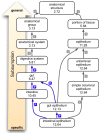Ontologies in quantitative biology: a basis for comparison, integration, and discovery
- PMID: 20520843
- PMCID: PMC2876043
- DOI: 10.1371/journal.pbio.1000374
Ontologies in quantitative biology: a basis for comparison, integration, and discovery
Abstract
As biology is becoming a data-driven discipline, ontologies become increasingly important for systematically capturing the existing knowledge. This essay discusses current trends and how ontologies can also be used for discovery.
Conflict of interest statement
The authors have declared that no competing interests exist.
Figures



Similar articles
-
Relations in biomedical ontologies.Genome Biol. 2005;6(5):R46. doi: 10.1186/gb-2005-6-5-r46. Epub 2005 Apr 28. Genome Biol. 2005. PMID: 15892874 Free PMC article.
-
Composite annotations: requirements for mapping multiscale data and models to biomedical ontologies.Annu Int Conf IEEE Eng Med Biol Soc. 2009;2009:2791-4. doi: 10.1109/IEMBS.2009.5333830. Annu Int Conf IEEE Eng Med Biol Soc. 2009. PMID: 19964601 Free PMC article.
-
Computation Resources for Molecular Biology: Special Issue 2018.J Mol Biol. 2018 Jul 20;430(15):2181-2183. doi: 10.1016/j.jmb.2018.05.041. Epub 2018 May 31. J Mol Biol. 2018. PMID: 29860026 No abstract available.
-
Biomedical ontologies: a functional perspective.Brief Bioinform. 2008 Jan;9(1):75-90. doi: 10.1093/bib/bbm059. Epub 2007 Dec 12. Brief Bioinform. 2008. PMID: 18077472 Review.
-
Behavior change interventions: the potential of ontologies for advancing science and practice.J Behav Med. 2017 Feb;40(1):6-22. doi: 10.1007/s10865-016-9768-0. Epub 2016 Aug 1. J Behav Med. 2017. PMID: 27481101 Review.
Cited by
-
De novo assembly of Agave sisalana transcriptome in response to drought stress provides insight into the tolerance mechanisms.Sci Rep. 2019 Jan 23;9(1):396. doi: 10.1038/s41598-018-35891-6. Sci Rep. 2019. PMID: 30674899 Free PMC article.
-
GMO Genetic Elements Thesaurus (GMO-GET): a controlled vocabulary for the consensus designation of introduced or modified genetic elements in genetically modified organisms.BMC Bioinformatics. 2021 Feb 5;22(1):48. doi: 10.1186/s12859-020-03880-0. BMC Bioinformatics. 2021. PMID: 33546585 Free PMC article.
-
The Vertebrate Trait Ontology: a controlled vocabulary for the annotation of trait data across species.J Biomed Semantics. 2013 Aug 9;4(1):13. doi: 10.1186/2041-1480-4-13. J Biomed Semantics. 2013. PMID: 23937709 Free PMC article.
-
Controlled vocabularies and ontologies in proteomics: overview, principles and practice.Biochim Biophys Acta. 2014 Jan;1844(1 Pt A):98-107. doi: 10.1016/j.bbapap.2013.02.017. Epub 2013 Feb 19. Biochim Biophys Acta. 2014. PMID: 23429179 Free PMC article. Review.
-
Ontologies as integrative tools for plant science.Am J Bot. 2012 Aug;99(8):1263-75. doi: 10.3732/ajb.1200222. Epub 2012 Jul 30. Am J Bot. 2012. PMID: 22847540 Free PMC article.
References
-
- Gruber T. R. A translation approach to portable ontology specifications. Knowledge Acquisition. 1993;5:199–220.
-
- Taylor W. R. The classification of amino acid conservation. J Theor Biol. 1986;119:205–218. - PubMed
-
- Murzin A. G, Brenner S. E, Hubbard T, Chothia C. SCOP: a structural classification of proteins database for the investigation of sequences and structures. J Mol Biol. 1995;247:536–540. - PubMed
-
- Orengo C. A, Michie A. D, Jones S, Jones D. T, Swindells M. B, et al. CATH–a hierarchic classification of protein domain structures. Structure. 1997;5:1093–1108. - PubMed
-
- Sonnhammer E. L, Eddy S. R, Durbin R. Pfam: a comprehensive database of protein domain families based on seed alignments. Proteins. 1997;28:405–420. - PubMed
Publication types
MeSH terms
LinkOut - more resources
Full Text Sources
Research Materials

